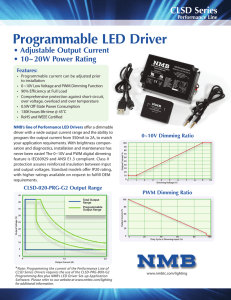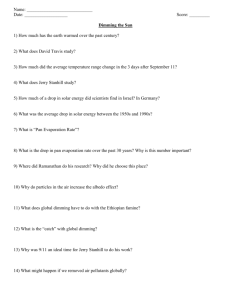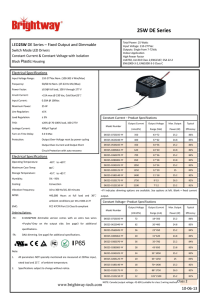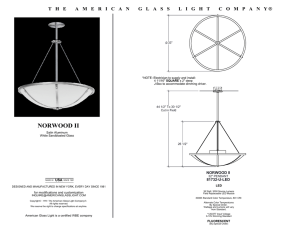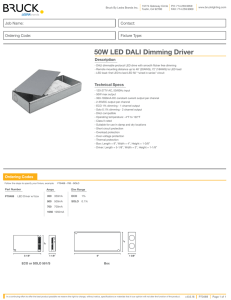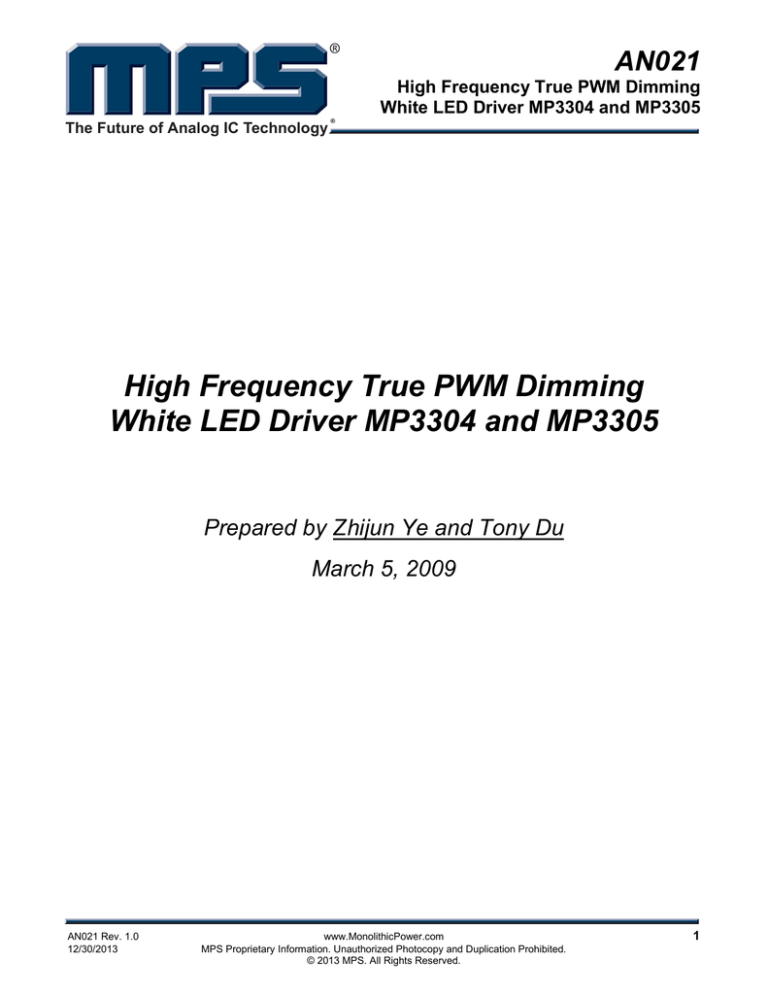
AN021
High Frequency True PWM Dimming
White LED Driver MP3304 and MP3305
The Future of Analog IC Technology
High Frequency True PWM Dimming
White LED Driver MP3304 and MP3305
Prepared by Zhijun Ye and Tony Du
March 5, 2009
AN021 Rev. 1.0
12/30/2013
www.MonolithicPower.com
MPS Proprietary Information. Unauthorized Photocopy and Duplication Prohibited.
© 2013 MPS. All Rights Reserved.
1
AN021 – HIGH FREQUENCY TRUE PWM DIMMING WHITE LED DRIVER MP3304 AND MP3305
As a new lighting industry revolution, the development of LED technology promoted innovative powersaving projects with worldwide attention. Compared with the traditional lighting source, White LED
(WLED) solutions can provide more luminance with less power-loss and for an extended range of
applications. In addition to LCD backlighting, WLEDs are also employed for low-power lighting fixture,
automobile lighting, decorative illumination, and camera flashlights.
Since the WLED brightness is required to be modified according to the actual situations, the WLED
driver must support an efficient solution for brightness dimming. The WLED’s brightness is controlled by
the forward current through the WLED devices. The voltage drop variations on WLEDs are not uniform,
so the exact and flexible output current control is particularly important for brightness regulation.
The current mainstream dimming modes include analog dimming and PWM (Pulse Width Modulation)
dimming:
The analog dimming control is a linear dimming mode that changes brightness by changing the
WLED’s forward current proportionally. It is easy to implement without potential EMC/EMI risk. But
based on the WLED’s characteristic, the color spectrum excursion is obvious following the change of
the WLED’s forward current and the human-eye is sensitive to this difference. So the WLED
manufacturers recommend a given forward current range for perfect brightness and color spectrum.
To guarantee more effective dimming control, the PWM dimming control is preferred to change
brightness by modulating the WLED’s forward current from a 0% to 100% duty-adjustable pulse. That is
the WLED brightness controlled by adjusting the relative ratios of the on time and the off time. If the
dimming frequency is higher than the human-eye sensitive range (>100Hz), we can only perceive the
effective brightness by averaging the on time and the off time. The average LED current corresponds to
the duty cycle of the PWM signal is shown in the following equation:
I LED _ AVG = D × I LED _ MAX
The maximum forward current is always constant at the recommended value during the on time, so
WLED color spectrum doesn’t vary as that in analog dimming. And it is also a pure digital dimming
mode. So PWM dimming mode is more popular for the current generation of WLED applications,
especially in complicated dimming control scheme.
The familiar PWM dimming frequency range is less than 1kHz. Due to the piezoelectric effect of the
ceramic capacitors and the oscillation of wire winding coil, the discrete low frequency (relative to the
WLED driver’s switching frequency) dimming cycles can possibly cause audible noise in the system.
Since the range of audio frequencies, usually from 15Hz to 20kHz, is audible to the normal human ear,
higher than 20kHz dimming frequency will give the designer more selection to prevent EMI and audio
problems.
MPS offers various solutions to drive WLEDs. MP3304 and MP3305 are new products whose high
frequency true PWM dimming technology provides high performance to meet the broader variety
dimming requirement.
This application note introduces WLED drive solutions based on MP3304 and MP3305.
MP3304 INTRODUCTION
MP3304 is an 8-pin power device integrated step-up WLED driver with fixed 2.2MHz operating
frequency suitable for driving arrays of WLEDs from 5V input or a single cell Lithium Ion battery. It
achieves 1.3A peak output current and incorporates both Enable and PWM dimming with a single
control pin. MP3304 features up to 50kHz true PWM dimming, which allows the flexible control of the
backlighting luminance under wide range of the ambient brightness, and also avoids the possibility of
PWM dimming audible noise. Complete fault condition protection includes under-voltage lockout,
AN021 Rev. 1.0
12/30/2013
www.MonolithicPower.com
MPS Proprietary Information. Unauthorized Photocopy and Duplication Prohibited.
© 2013 MPS. All Rights Reserved.
2
AN021 – HIGH FREQUENCY TRUE PWM DIMMING WHITE LED DRIVER MP3304 AND MP3305
cycle-by-cycle peak current limiting, output over-voltage shutdown and thermal overload protection
preventing damage in the event of an output overload. (Please refer to datasheet of MP3304 for details.)
The MP3304 has several selections on the over-voltage protection threshold as the Table 1 shown
below:
Table 1—MP3304 OVP Shutdown Threshold
Part Number
OVP Threshold (VOVP)
MP3304A
38V
MP3304B
26V
MP3304C
20V
The MP3305 has an OVP pin which can be used for programming the over voltage protection threshold
externally with a resistor divider. In the following sections, the MP3304 is taken for detailed explanation.
REFERENCE DESIGN
WLED array is the common configuration for backlight applications. Conventionally, the step-up
converters are used in the WLED driver application from a single cell Lithium Ion battery. Configured in
boost mode, MP3304 can well regulate the WLED current to follow the variety of applications.
The step-up configuration with MP3304 for the LCD panel backlight application is shown in Figure 1.
The backlighting source is a WLED array (3 WLEDs in series, 10 strings paralleled). It is suitable for the
portable system that the input voltage could be both the batteries and the adapter input. The detailed
design specifications and BOM list are shown in Table 2 and Table 3.
L1
D1
VIN
3
C1
E/D
GND
1
IN
5
8
SW
C2
10 x 3
EN/DIM
GND
U1
MP3304
LED
PGND
ISET
2
6
Backlight Board
7
R1
Figure 1—Application for Driving WLED Array
AN021 Rev. 1.0
12/30/2013
www.MonolithicPower.com
MPS Proprietary Information. Unauthorized Photocopy and Duplication Prohibited.
© 2013 MPS. All Rights Reserved.
3
AN021 – HIGH FREQUENCY TRUE PWM DIMMING WHITE LED DRIVER MP3304 AND MP3305
Table 2—Specifications for Driving WLED Array
5V±10%
9V ~ 11V
200mA
Yes
Input Voltage
LED Forward Voltage
LED Current
Open LED Protection
Table 3—BOM List for Driving WLED Array
Qty Ref
1
1
1
1
1
1
Value
Description
Package
Manufacturer
C1
4.7uF
Ceramic Capacitor,16V,X5R
0805
muRata
C2
2.2uF
Ceramic Capacitor,25V,X7R
0805
muRata
D1
B0530
Diode Schottky
SOD-123
Diodes Inc.
L1
2uH
Inductor 2.8A
D53LC
TOKO
R1
1Ω
1%
0805
Yageo
U1 MP3304CDD
MPS WLED Driver
QFN8(2x3mm)
MPS
Manufacturer P/N
GRM21BR61C475KA88
GRM21BR71E225KA73L
B0530W
D53LC-#A915AY-2R0M
RC0805FR-071RL
MP3304CDD-LF-Z
With the integrated power device, internal compensation and protection mechanism, the external
component count required by MP3304 is minimized.
The input filter capacitors (C1) are recommended with X5R or X7R dielectrics ceramic capacitor for low
ESR and small temperature coefficients. The voltage stress applied on the rectifier diode (D1) is VO,
considering some derating of the diode in practical applications, a 500mA/30V Schottky diode can be
used for most applications.
The recommended inductance value can be derived from the following equation:
L=
VIN × (VOUT − VIN )
VOUT × ΔI L × f sw
Eq. 1
Where VIN is the lowest input voltage, VOUT is the output voltage, ΔIL is the inductor ripple current,
For MP3304 in boost mode, designingΔIL approximately equal to 0.6A is a good choice.
In this application, VIN-MIN=4.5V, VOUT=11V, fSW=2.2MHz, the calculated L=2μH. So a 2μH inductor could
be selected.
For most application, a 2μH to 10μH with suitable DC current rating is recommended. If the calculation
of above equations results in an inductance greater than 10μH, a 10uH inductor is still preferred.
The output capacitor keeps the output voltage ripple small and ensures feedback loop stability. A 1μF
to 10μF ceramic capacitor with adequate rating will be sufficient.
MP3304 is turned off if an over-voltage condition is present due to an open circuit condition. The Over
Voltage Protection (OVP) function is triggered by SW pin. If the SW voltage goes too high, the Open
Load protection will shut off MP3304. In some cases an LED may fail, this will result in the feedback
voltage always being zero. The part will run at maximum duty cycle boosting the output voltage higher
and higher. If the output voltage ever exceeds the open load protection threshold voltage, MP3304 will
shut down. The part will not switch again until the power is recycled.
To make sure the MP3304 functions properly and to avoid the OVP detection mistriggering, careful
attention must be paid to the PCB board layout and component placement to reduce the noise on SW
pin. Proper layout of the high frequency switching path is critical to prevent noise and electromagnetic
AN021 Rev. 1.0
12/30/2013
www.MonolithicPower.com
MPS Proprietary Information. Unauthorized Photocopy and Duplication Prohibited.
© 2013 MPS. All Rights Reserved.
4
AN021 – HIGH FREQUENCY TRUE PWM DIMMING WHITE LED DRIVER MP3304 AND MP3305
interference problems. The loop of MP3304 SW to GND pin, output diode, and output capacitor is
flowing with high frequency ripple current, it must be as short as possible. And the proper output cap
value is also helpful.
The internal reference for the output current is 0.2V. With a given output current ILED, the current
sense resistor can be calculated by Eq. 2:
RSENSE =
0.200
I LED
Eq. 2
Where RSENSE is the resistor R1 in Figure1.
For 200mA output LED current in the application shown in Figure 1, a 1Ω current sense resistor is
required.
Figure 2 shows the bench-test waveform for this design. The input voltage is 5V and the output LED
current is regulated to 200mA. The OVP threshold of MP3304C is about 20V.
SW
5V/div
SW
10V/div
FB
50mV/div
ILED
100mA/div
VOUT(AC)
100mV/div
VOUT
5V/div
IINDUCTOR
500mA/div
400ns/div
(a) Steady State Operation (Vin=5V)
(b) Open Load Protection (VOVP=20V)
Figure 2—The Bench-test Waveform for Reference Design
HIGH FREQUENCY TRUE PWM DIMMING
MP3304 accpets PWM dimming and Enable signals with a single control pin. When VEN/DIM – VGND is
less than 0.4V, the chip is turned off. If VEN/DIM – VGND is higher than 1.8V, maximum WLED current will
be generated. If a PWM dimming signal is applied, its high level must be greater than 2V and low level
must be lower than 0.4V. The PWM square waveform frequency can be set from 250Hz to up to 50kHz,
which is beyond audible spectrum.
MP3304 uses the integrated dimming control switch to modulate the output WLED current. (MP3304
dimming configuration is shown in Figure 3) During dimming on time, the dimming switch is turned on
to conduct the WLED current. The LED current flows into LED pin and out from ISET pin, LED current
is hence sensed at the ISET pin for step-up converter feedback regulation. When the PWM signal is off,
the dimming switch cuts off the WLED current conduction loop to turn off the WLED. So the WLED
current vanish very quickly. Once the dimming switch is disconnected, the chip stops boost switching
simultaneity and the output voltage remains almost unchanged. The boost switching resumes to normal
operation at the beginning of the next PWM period. As the output voltage keeps at a DC voltage without
dimming frequency ripple. The audible noise can be prevented.
AN021 Rev. 1.0
12/30/2013
www.MonolithicPower.com
MPS Proprietary Information. Unauthorized Photocopy and Duplication Prohibited.
© 2013 MPS. All Rights Reserved.
5
AN021 – HIGH FREQUENCY TRUE PWM DIMMING WHITE LED DRIVER MP3304 AND MP3305
Boost Output
Voltage
DIMMING
SWITCH
LED
PWM Dimming
Control
Feedback
to EA
ISET
Rs
Figure 3—Internal Dimming Configuration
Figure 4 shows the dimming-test waveform and curve. Due to the dimming control switch, the output
WLED current is modulated by PWM dimming signal. The average WLED current changes linearly with
the wide frequency range of the PWM dimming duty cycle ratio.
fPWM=50kHz, DPWM=50%
Figure 4—The Dimming-test Waveform and Curve for Reference Design
AN021 Rev. 1.0
12/30/2013
www.MonolithicPower.com
MPS Proprietary Information. Unauthorized Photocopy and Duplication Prohibited.
© 2013 MPS. All Rights Reserved.
6
AN021 – HIGH FREQUENCY TRUE PWM DIMMING WHITE LED DRIVER MP3304 AND MP3305
CONCLUSION
Compared to other white LED driver, MP3304 is an excellent high frequency dimming solution for
WLED driver with the following advantages:
z
Low cost off-the-shelf components
z
Internal 40V power switch
z
Wide PWM dimming frequency range (250Hz to 50kHz)
z
High Frequency true PWM dimming with audible noise prevention
NOTICE: The information in this document is subject to change without notice. Users should warrant and guarantee that third
party Intellectual Property rights are not infringed upon when integrating MPS products into any application. MPS will not
assume any legal responsibility for any said applications.
AN021 Rev. 1.0
12/30/2013
www.MonolithicPower.com
MPS Proprietary Information. Unauthorized Photocopy and Duplication Prohibited.
© 2013 MPS. All Rights Reserved.
7

